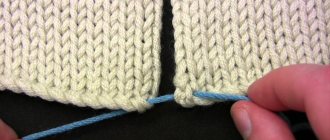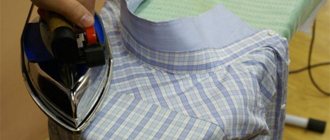How to make a shirt a size smaller
It is difficult to make a shirt that is too wide, but making it a size smaller is a matter of one evening.
Prepare your tools:
- several needles of different thicknesses for piercing the material;
- fixing pins;
- centimeter for measuring measurements;
- sharpened tailor's scissors
- chalk.
The sewing process is almost the same for both women's and men's clothing items.
First you need to decide in which places the item is too big, then start repairing it. Experienced seamstresses recommend wearing items inside out. This makes it more convenient to take away the excess fabric, pin it together, and mark out new lines for the stitches.
After this procedure, turn it inside out and try it on.
The easiest way is to fit it. When doing this work, the main thing is not to make folds along the line.
It is better to sew a product with a seam in the middle of the back not along this seam, but along the sides, making a rounded stitch.
The work process step by step:
- Put the shirt on the person inside out, that is, facing the body.
- Starting from the bottom seam, pin the fabric together so that a slight rounding is formed in the waist area.
- Above the waist, pin the shirt 10-15 cm upward, making a smooth transition from the new line to the old one.
- Lay the product out on a flat surface and carefully lay a basting thread.
- Sew along the basting, trim off excess fabric.
- Finish the cut with a zigzag.
If the shirt is wide at the shoulders
In the case when the product turns out to be a size larger than necessary, it is quite possible to reduce it by sewing the armhole, shoulders and sides. We offer step-by-step instructions on how to sew a shirt a size smaller:
- Initially, you should determine how many centimeters you need to reduce each item of clothing. We recommend writing down the dimensions as they should be the same on both sides.
- After turning the shirt inside out, be sure to mark with chalk the lines of the future stitching location, drawing it along the entire existing side seam and armhole. All marked lines must be secured with pins.
- Open out the old armhole and side stitches of the product, and then trim off the excess fabric.
- It is recommended to make new seams using a sewing machine, if available. And all edges of the cuts need to be overcast manually or using an overlocker.
It is important that the lines on both sides are completely symmetrical. If a new item is being sewn in, it should be washed before sewing.
Shirt sleeve repair
First of all, here is how long the sleeve should be:
A man's shirt often has to be shortened not only in length, but also the sleeves. Many dressmakers are confused by the cuff.
You can shorten sleeves with cuffs in two ways. But first you need to determine the length of this part. The cuff should reach the bone, which is located at the base of the thumb, that is, extend beyond the edge of the jacket sleeve by about 1.5 centimeters.
Easy way
You can only shorten the shirt in a simple way that is always worn with a jacket, since you will have to make a reduction approximately in the elbow area.
Put on a shirt, pin up excess fabric, check the length is correct, sew on a machine, remove excess fabric.
Another way without touching the slot:
- Open the cuff and secure the folds with pins.
- Measure the length to be removed, not forgetting the seam allowance.
- Trim off excess fabric.
- Sew on the cuff.
Complex repair option
How to properly remake a sleeve, cutting off the splines:
- Open the cuff, pin the folds completely, or better yet, sweep them away so they don’t come apart.
- Undo the splines.
- Shorten the sleeve at the bottom, leaving an allowance of 1 cm.
- Measure the size of the old spline.
- Mark a new slot: set aside the same length from the bottom cut line that it had.
- Make a cut for a new spline.
- In the upper part of this part, make a triangular cut equal to the one that was there.
- When turning splines, start working with a narrow element. Sew it down into a triangle at the top of the cut.
- Next, stitch on the wide facing.
- Sew on the cuff and topstitch.
How to shorten your sleeves
Probably every second fashionista had a situation when the shirt model she liked was wide enough for future use, but at the same time had long sleeves. To correct such a defect, you can alter the cuff yourself. To do this, you need to flog them both and cut the sleeve to the desired length. The line of the side seam of the sleeve must also be changed, as indicated in the article above.
An important condition is that the width of the sleeve is equal to the length of the cuff. Before sewing a shirt, you should carefully take measurements and carefully sew in the cuff, because sleeves are an important element of the product that is constantly in sight.
Reducing shoulder width
The product is wide at the shoulders and is not difficult to reduce to the desired size. If the shirt is not too large, then it can be sewn in without ripping.
Without ripping
- Measure the length from the collar to the end of the shoulder, mark.
- From this mark, draw a line with chalk to the armpit along the front and back.
- Cut the fabric along the drawn line, leaving an allowance.
- Pin the top of the cut piece to the end of the shoulder line.
- Baste with back and shelf. The size of the armhole has become larger, so it needs to be reduced. The reduction is described above in the text
- Sew the joined parts and iron them.
Repair with ripping
- Use a seam ripper to cut out the sleeves.
- Determine the length of the shoulder, draw with chalk on the fabric. Check symmetry.
- Cut off the excess fabric, connect the sleeves to the back and front, and sweep. If the sleeve does not coincide with the reduced armhole, then it should also be sutured.
- Double stitch.
What to do if the shirt is too big in all respects? It is necessary to complete all stages in turn. First sew in the shoulders, then the armholes, then along the side seams. Then shorten and sew in the sleeve.
The last step is to shorten the shirt. It is necessary to mark the desired length, bend the fabric 2 centimeters, and baste. Then iron it, make another fold, iron it, and sew it on a machine. A woman's shirt can be hemmed on the arms.
Let's start cutting
Using the matching shirt as a guide, trim the sleeves and excess from the sides of the larger shirt you plan to mend.
Be sure to leave enough seam allowance. For a better fit, you can add extra inches to the armholes on the back of the shirt only. I didn’t do this on my shirt, but I think the idea itself is good.
Smooth and fresh skin: dermaplaning, or why a woman needs to shave her face
Rare shot: Viktoria Isakova showed her grown-up daughter from Yuri Moroz (new photo)
Women's jeans: before you buy them, you need to pay attention to one detail
On the other side of the shirt, also trim off any excess fabric and make sure that the pieces match.
How to sew a collar
If the collar is large, then it is better to take the men's shirt to a tailor. Only an experienced seamstress can do this job.
A women's blouse with a soft collar can be repaired with your own hands.
Stages of work:
- Open the collar, turn it inside out, then fold it in half, find the middle, mark it so as not to lose it. Spread it apart, retreating from the middle by 7-8 centimeters in both directions.
- Measure how long it needs to be sewn, baste on both parts of the collar, sew on a machine, cut off excess fabric, smooth out the seams.
- Machine sew the torn part.
- If the collar of the blouse has become larger, it must be sewn in along the shoulder line or along the seam on the back.
- Sew the collar in place
Shortening the product
Reducing the length of a product is easy, even without a sewing machine. To form a stitch, you need to use the thinnest possible needle.
Let's look at the sequence of how to sew a shirt lengthwise:
- An important point at the beginning of the work is to determine how much fabric needs to be trimmed.
- Be sure to mark the location of the future cut with soap or chalk.
- 1-1.5 cm should be set aside from the drawn line at the bottom of the shirt to form a stitch.
- Trim off the excess fabric and secure the new seam line with pins.
- After the seam is stitched by machine or formed by hand, the product must be carefully ironed.
Wide blouse requires suturing
I liked the blouse, but it is too wide. It's okay, it can be reduced. You can sew the blouse in width by using darts and reducing the side seams.
Excess width can be taken into the side seams. At the same time, you need to understand that you will have to reduce the armhole and sleeve width by the same number of centimeters as the side seam or make the armhole deeper so that the sleeve fits into it.
Darts at the back
It's easy to make darts. Follow the advice from experienced craftswomen: make a dart pattern on paper, cut out the location of the dart. Turn the blouse inside out and fold it in half.
Having marked the middle, set aside 10 centimeters from it in both directions. Using the pattern, simply trace the cut out dart on one and the other side of the product with chalk. The upper corner should reach the chest, and the lower corner should reach the hips.
Pin out the darts, try on the product to make sure it fits your figure. Then sweep and smooth the darts to the sides.
What about the collar?
Alas, it is almost impossible to adjust this element of the product yourself. Many tailors can reduce the circumference, but most likely a new vertical seam will appear behind the shirt on the collar.
Re-sewing a button will also cause the shirt to lose its presentable appearance. The only correct solution to this problem would be to completely replace the entire collar structure on both men's and women's shirts.
Knowing how to sew a women's shirt and a men's shirt, it is quite possible to replenish your wardrobe with new stylish things. With maximum concentration and basic skills, you can quickly turn a shapeless item into a stylish addition to your basic wardrobe.
How to make a uniform shirt smaller
Often military, police, and railway workers are given a larger shirt. Is it possible to reduce the size of a uniform item? The principles of reduction are no different from the repair procedure for all types of this wardrobe item.
You should reduce your military shirt size by one size without ripping. Pin the shirt, starting from the shoulder to the armpit, sweep it, iron it. Sew by machine. Cut off the excess fabric and process the cut using an overlocker.
If the product has elastic, then along the side seams it should be reduced to elastic:
- Open the sleeve, reduce the side seam.
- Reduce sleeve width.
- Sew on the sleeve.
If the product is large at the shoulders, then you can reduce it in this way:
- On the shirt owner, measure the required distance from the collar to the shoulder line, mark with chalk.
- Lay the shirt out on the table and draw the line of the future seam along the marked line. Fold the product in half and make a symmetrical mark on the other side of the product.
- Cut along the drawn line. Cut a few millimeters from each sleeve and baste to the central part of the shirt.
- Sew on a machine, remove excess fabric, zigzag along the cut.
If the collar is soft, then decrease it as on a women's blouse.
What you might need for work
To alter the finished product, you need to find free time and prepare special sewing supplies:
- Centimeter and ruler. These items are necessary in order to take measurements. In some areas of the finished product you need to retreat a few millimeters or centimeters, strictly observing a straight line. This applies to marking side seams, as well as drawing a line to finish the edge of a shirt or blouse.
- Pins or needles. Using pins or small needles, parts of the shirt are held together when sections need to be joined before further basting.
- Chalk. The area is marked with chalk, which is later fastened with pins and basted with thread.
- Scissors with sharp edges. Scissors are necessary for making cuts and cutting parts of the shirt. The sharper the scissors are, the less likely it is to damage the product.
- Threads. Colored threads are used for basting: they are better visible on the fabric. Only threads that match the shade of the fabric on the shirt are suitable for sewing.
- Needles. Basting is done using a needle. After parts of the shirt are sewn on the machine, the basted seam, made by hand with a needle, is removed.
- Sewing machine. When reducing a product by a size, it is wiser to use an automatic sewing machine. The automatic process will produce smooth seams that will be indistinguishable from factory-quality seams.
Reference! In addition to chalk, you can use a small dry piece of soap.
Sewing a children's shirt
To sew a sleeveless shirt for a child, you should turn it inside out and lay it out on the table. Next, mark the new lines for stitching with chalk. Seamstresses recommend immediately taking into account the width of the sleeve.
Baste with thread, try on, sew on a machine. The rest of the repair of the product is done in the same way as on adult things.
Finally: we have made a selection of recommendations from experienced seamstresses on how to sew a shirt. They achieved results through experience. If you have your own techniques for repairing shirts, write in the comments. They will come in handy too. Learning new things is always interesting.
How to sew the sleeves of men's and women's shirts
To reduce the width of a sleeve without a cuff by 3-5 mm, you should initially turn the product inside out and lay it out so that the fabric is not deformed. The required distance is measured with a measuring tape, and a line is drawn along the entire sleeve along which the seam will run.
Please note that if you need to remove only 3 mm from a shirt sleeve, then only 1.5 mm should be removed from the existing seam. This is explained simply - you will cut off 1.5 mm on both sides of the sleeve, which in total will give the required 3 mm.
After drawing a line and securing the fabric with pins, a seam is formed using a sewing machine or manually with a needle and thread.
How to sew in a shirt by more than 5 mm? To do this, you need to open the side seam near the armhole under the sleeve, cut off the excess fabric, and then carefully sew it up.
Correction of armhole and sleeve drawings
An incorrect armhole that does not allow a sleeve of the desired shape to be sewn in is corrected using seam allowances. If they are not on the pattern, do not forget to increase the required values.
How to change the height of a sleeve where it touches the shoulder
- Determine the fit allowance - subtract the length of the armhole from the length of the sleeve at the seam.
- Cut the sleeve pattern at the top according to the level of the marks.
- Arrange or align the sleeve parts by overlapping them - the height should coincide with the measurements of the finished product.
- Adjust the sleeve line according to the marks and make a smooth roll.
- Determine the size of the new armhole - subtract the original allowance for a loose fit from the length of the hem along the seam.
- On two-seam parts, the top and bottom are aligned along a single seam line from the edge of the hem. A line is drawn perpendicular to the thread in the shoulder part of the sleeve - through the lower sewing point in the armpit.
Reducing the armhole on a sleeveless pattern
- Reduce the width of the bodice in the basic drawing along the front and back by 1 centimeter across the bust.
- Connect the resulting marks with segments to the points on the side cut at waist level.
- Continue the segments upward and smoothly draw the outlines of the armhole from the resulting vertices.
- If you need to lower the neckline, then increase the shoulder cut (the standard is 1.5 centimeters, so you don’t have to correct the cuff along the sleeve).
- Transfer the basic patterns onto paper and continue the shoulder cut along the front and back in a smooth arc.
- Set aside 1.5 centimeters from the original armhole and smoothly connect the new mark with the neckline at the same width as the chest and back.
vovk.com
If the sleeve is set-in, then you can only lower the neckline to a certain level. If a significant indentation is needed, use a kimono-type cut pattern. On items without sleeves, you will need to lengthen the shoulder along the cut on the front and back - up to 4 cm.











